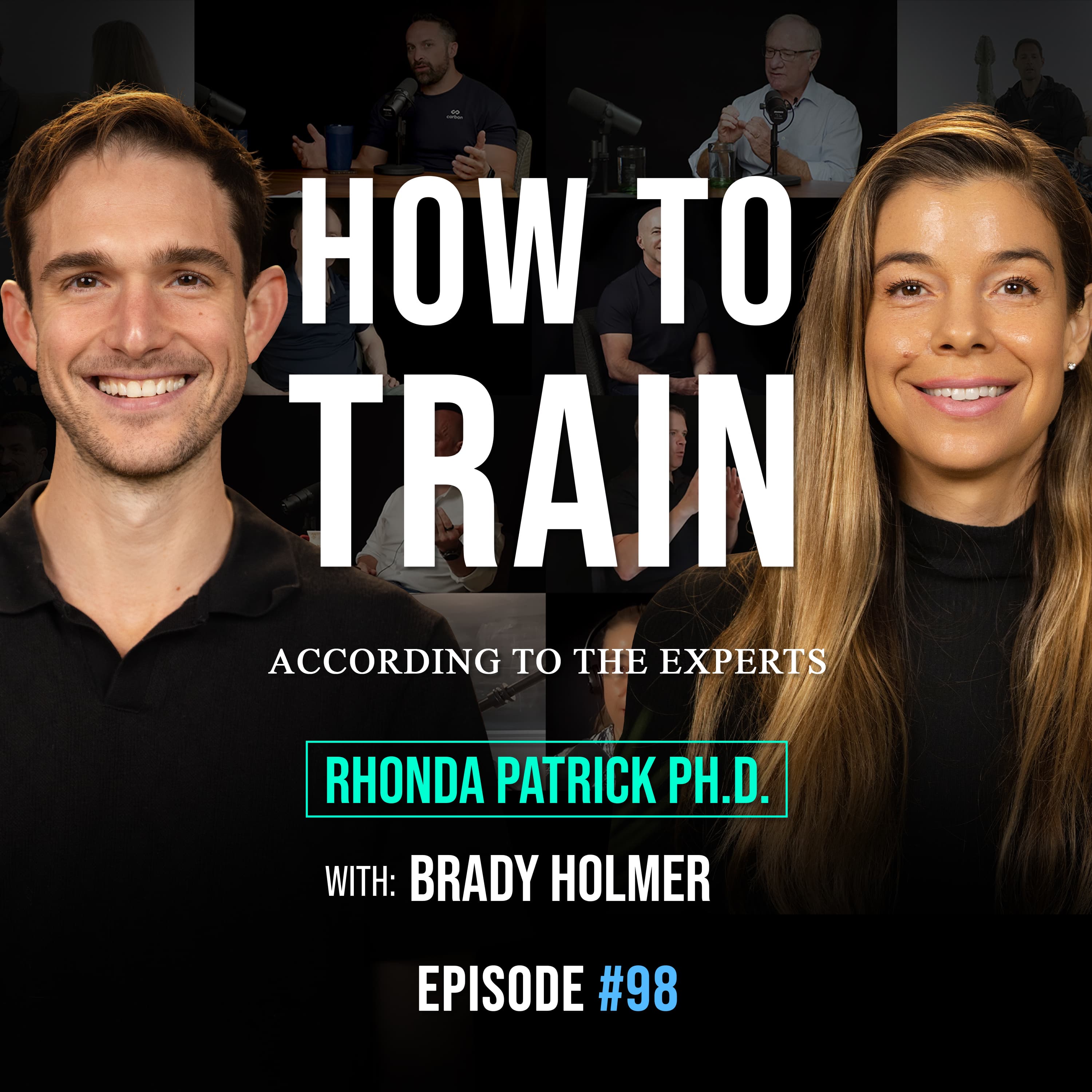
February 3, 2025 • 2hr 52min
#098 How to Train According to the Experts
FoundMyFitness

Key Takeaways
- Cardiorespiratory fitness is one of the most important biomarkers for longevity and overall health
- 3 weeks of bed rest is worse for cardiovascular health than 30 years of aging, highlighting the dangers of sedentary behavior
- 4-5 days per week of aerobic exercise appears to be the optimal dose for maintaining cardiovascular health with age
- High-intensity interval training (HIIT) provides unique benefits for improving VO2 max, mitochondrial health, and glucose regulation compared to moderate-intensity exercise
- Resistance training is crucial for maintaining muscle mass, strength and power with age - aim for at least 2-3 sessions per week
- Heat exposure (sauna) can enhance cardiorespiratory fitness adaptations when combined with exercise
- Protein intake of 1.6g/kg body weight optimizes muscle growth with resistance training
Introduction
This special episode features Brady Holmer, an accomplished endurance athlete and exercise science communicator, discussing evidence-based protocols for enhancing muscle strength and cardiovascular health. The conversation covers optimal exercise protocols for reversing heart aging, improving VO2 max, building strength and muscle, and maintaining metabolic health.
The Importance of Cardiorespiratory Fitness (8:24)
Cardiorespiratory fitness, measured as VO2 max, represents the body's integrative ability to take in, distribute and utilize oxygen. It's measured during maximal exercise testing and serves as a powerful predictor of longevity and health outcomes.
- Gold standard measurement involves incremental exercise test to exhaustion with gas exchange analysis
- Can be estimated using field tests like Cooper 12-minute run or smart watch algorithms
- Low cardiorespiratory fitness carries mortality risk comparable to smoking and type 2 diabetes
- High VO2 max associated with 5-year increased life expectancy in studies
Training Zones and Exercise Intensity (22:42)
The experts defined 5 training zones based on heart rate, perceived exertion (RPE), and the talk test:
- Zone 1 (Recovery): 50-60% max HR, RPE 6-8, can hold full conversation
- Zone 2 (Light-Moderate): 60-70% max HR, RPE 9-12, can converse but breathing heavier
- Zone 3 (Threshold): 70-80% max HR, RPE 13-15, can speak in short phrases
- Zone 4 (High Intensity): 80-95% max HR, RPE 16-18, can speak 1-2 words
- Zone 5 (Maximum): 95%+ max HR, RPE 19-20, cannot speak
High-Intensity Interval Training Protocols (45:13)
Several evidence-based HIIT protocols were discussed for improving cardiorespiratory fitness:
- Norwegian 4x4: 4 minutes hard effort followed by 3 minutes recovery, repeated 4 times
- 10x1: 1 minute on, 1 minute off for 10 rounds
- Tabata: 20 seconds maximum effort, 10 seconds rest for 8 rounds
- Key principle: Intervals should be sustainable but challenging intensity
Cardiovascular Structure and Aging (51:07)
Dr. Benjamin Levine's research revealed important insights about heart aging and exercise:
- Heart stiffening begins in early middle age (35-50 years)
- Heart atrophy occurs in late middle age (50-65 years)
- Masters athletes maintain hearts structurally similar to healthy 30-year-olds
- 4-5 days/week of exercise provides significant protection against heart aging
Exercise Protocol for Reversing Heart Aging (1:02:16)
A landmark 2-year study demonstrated reversal of 20 years of cardiac aging through:
- One HIIT session per week (Norwegian 4x4 protocol)
- One 60+ minute base pace session per week
- One 30-minute moderate intensity session
- Two resistance training sessions per week
- Active recovery days after intense sessions
Exercise Snacks and VILPA (1:36:20)
Short bursts of vigorous activity throughout the day can provide significant health benefits:
- Structured snacks: 1-10 minutes of elevated heart rate (80%+ max HR)
- Unstructured VILPA: Vigorous intermittent lifestyle physical activity
- Benefits: 50% reduction in all-cause mortality with 1-2 minutes 3x/day
- Examples: Stair climbing, brisk walking, bodyweight exercises
Resistance Training Principles (1:50:04)
Key principles for effective resistance training include:
- Consistency in training frequency and execution
- Progressive overload to continually challenge muscles
- Adequate recovery between sessions
- Focus on execution rather than perfection
- Compound exercises for maximum efficiency
Training for Strength vs Hypertrophy (2:12:16)
Different protocols optimize different outcomes:
- Strength training: 85%+ 1RM, lower reps (1-5), longer rest (2-5 min)
- Hypertrophy training: 60-80% 1RM, higher reps (6-12), shorter rest (1-2 min)
- Both benefit from compound exercises and progressive overload
- Training to failure not necessary for optimal results
Heat Exposure and Exercise (2:31:16)
Sauna use can enhance exercise adaptations:
- Improves VO2 max more than exercise alone
- 2-4 sessions/week at 175°F for 20 minutes optimal
- May support muscle hypertrophy when combined with resistance training
- Avoid cold exposure immediately after resistance training
Protein and Supplementation (2:41:21)
Nutritional strategies to support training:
- Protein intake: 1.6g/kg body weight optimal for muscle growth
- Distribution: 3-4 meals with 25-30g protein throughout day
- Timing window: Not critical but aim to eat within 2-3 hours post-exercise
- Creatine: 5-10g daily for improved strength and recovery
Conclusion
The comprehensive discussion provides evidence-based protocols for optimizing both cardiovascular and muscular health through various forms of exercise. The key is finding sustainable approaches that incorporate both aerobic and resistance training, while potentially leveraging complementary strategies like heat exposure and proper nutrition. The guide serves as a practical roadmap for implementing these research-backed recommendations into a comprehensive training program.









